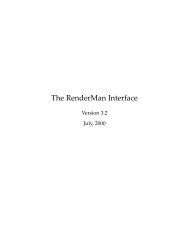Controlling Fluid Simulations with Custom Fields in Houdini Master ...
Controlling Fluid Simulations with Custom Fields in Houdini Master ...
Controlling Fluid Simulations with Custom Fields in Houdini Master ...
You also want an ePaper? Increase the reach of your titles
YUMPU automatically turns print PDFs into web optimized ePapers that Google loves.
1 AbstractThere are various dierent algorithms and techniques for uid simulation, bothphysical simulation and more artistic simulation. Some of these techniquesare available to the general public through exist<strong>in</strong>g 3d software packages. Thepurpose of this thesis is about develop<strong>in</strong>g a workow that provides more controlfor artistic uid simulation <strong>in</strong> Houd<strong>in</strong>i. This workow consists of two ma<strong>in</strong>elements, the development of a tool that helps <strong>with</strong> the creation of customvolumetric elds and the implementation of these elds <strong>in</strong> Houd<strong>in</strong>i's dynamiccontext.2 Introduction<strong>Fluid</strong>s and gaseous materials are hard to art direct. Physical simulation of reand smoke can result <strong>in</strong> realistic results, but can also make it harder to controlthem as they are bound by certa<strong>in</strong> rules. For certa<strong>in</strong> shots <strong>in</strong> lms a physicallyimpossible behaviour might be required and that is when artists need to be ableto truly direct where the smoke or re needs to go and how it needs to get there.In two dimensions it is straightforward to pa<strong>in</strong>t strokes on a canvas to denewhere certa<strong>in</strong> densities, colours or other properties should be. In a 3D eld itbecomes a lot harder to dene these artistic strokes.Sometimes it is not the movement that needs to be dierent, but the look.There might be a demand to mix dierent types of smoke together, for <strong>in</strong>stancea red gas and a blue gas form<strong>in</strong>g purple gas when they mix. If this colourproperty is l<strong>in</strong>ked to the behaviour perhaps only the red gas is <strong>in</strong>ammable, orperhaps they become <strong>in</strong>ammable when they start mix<strong>in</strong>g, similar to chemicalreactions. Because of this complexity <strong>in</strong> both look and behaviour, software thatcan handle this could be a useful tool. This project focuses on the developmentof a tool and workow that can provide this k<strong>in</strong>d control <strong>in</strong> Houd<strong>in</strong>i.3 Previous work3.1 IntroductionThere are several approaches to creat<strong>in</strong>g volumetric eects. The two ma<strong>in</strong>approaches are either us<strong>in</strong>g a large amount of very transparent particles asdeveloped by Frantic Films [1] and render<strong>in</strong>g them to an accumulation buer orus<strong>in</strong>g a voxelgrid, ray-march<strong>in</strong>g through the volume [8]. Both approaches couldbenet from additional user control through custom elds. However, most of thecurrent solutions are either part of visual eects studios proprietary software,or programmed <strong>in</strong> isolated simulators.Some of the uid solvers that are <strong>in</strong>corporated <strong>in</strong> ma<strong>in</strong>stream 3d applicationsprovide not enough control to be able to create more advanced visual eects.A plug-<strong>in</strong> such as FumeFx for 3dsmax is basically a black box <strong>with</strong> little extracontrol beyond the provided parameters. Similarly the uid solver <strong>in</strong> Maya is3















